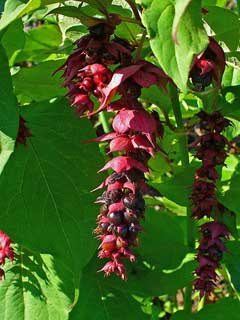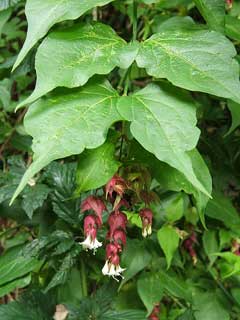 |
|
http://commons.wikimedia.org/wiki/User:Llez |
 |
| http://commons.wikimedia.org/wiki/User:MPF |
Translate this page:
Summary
Bloom Color: Red, White. Main Bloom Time: Early fall, Late summer. Form: Oval.
Physical Characteristics

 Leycesteria formosa is a deciduous Shrub growing to 2.5 m (8ft) by 2.5 m (8ft) at a medium rate.
Leycesteria formosa is a deciduous Shrub growing to 2.5 m (8ft) by 2.5 m (8ft) at a medium rate.
See above for USDA hardiness. It is hardy to UK zone 7. It is in flower from June to September, and the seeds ripen from October to November. The species is hermaphrodite (has both male and female organs) and is pollinated by Insects.
It is noted for attracting wildlife.
Suitable for: light (sandy), medium (loamy) and heavy (clay) soils and can grow in nutritionally poor soil. Suitable pH: mildly acid, neutral and basic (mildly alkaline) soils. It can grow in semi-shade (light woodland) or no shade. It prefers moist soil. The plant can tolerates strong winds but not maritime exposure.
It can tolerate atmospheric pollution.
UK Hardiness Map
US Hardiness Map
Synonyms
Plant Habitats
Woodland Garden Dappled Shade; Shady Edge;
Edible Uses
Edible Parts: Fruit
Edible Uses:
Fruit? - one unconfirmed report said that the fruit is edible. In the better forms, the fully ripe and very soft fruit is very sweet with a treacle-like flavour, though in other forms it has a very bitter taste and is not very desirable[K].
References More on Edible Uses
Medicinal Uses
Plants For A Future can not take any responsibility for any adverse effects from the use of plants. Always seek advice from a professional before using a plant medicinally.
None known
References More on Medicinal Uses
The Bookshop: Edible Plant Books
Our Latest books on Perennial Plants For Food Forests and Permaculture Gardens in paperback or digital formats.

Edible Tropical Plants
Food Forest Plants for Hotter Conditions: 250+ Plants For Tropical Food Forests & Permaculture Gardens.
More

Edible Temperate Plants
Plants for Your Food Forest: 500 Plants for Temperate Food Forests & Permaculture Gardens.
More

More Books
PFAF have eight books available in paperback and digital formats. Browse the shop for more information.
Shop Now
Other Uses
References More on Other Uses
Cultivation details
Landscape Uses:Seashore, Specimen, Woodland garden. Succeeds in most fertile soils, preferably of a woodland nature[1, 11]. In Britain it grows better in full sun than in shade[11]. Tolerates limy soils[200]. Tolerates urban pollution, maritime conditions and windswept locations[200], though not full maritime exposure[K]. This species is hardy to -15°c[184], it can be cut to the ground in severe winters but usually resprouts from the base[200]. The flowers, which are delicately scented, are borne at the end of the current season's growth[245]. Birds, especially pheasants, are very fond of the fruit[11, 182]. Plants frequently self-sow when growing in suitable conditions[182]. Plants do not normally need pruning though weak shoots can be cut back to ground level in the spring in order to encourage more vigorous growth[188]. Special Features:Attracts birds, Not North American native, Naturalizing, Wetlands plant, Attractive flowers or blooms.
References Carbon Farming Information and Carbon Sequestration Information
Temperature Converter
Type a value in the Celsius field to convert the value to Fahrenheit:
Fahrenheit:
The PFAF Bookshop
Plants For A Future have a number of books available in paperback and digital form. Book titles include Edible Plants, Edible Perennials, Edible Trees,Edible Shrubs, Woodland Gardening, and Temperate Food Forest Plants. Our new book is Food Forest Plants For Hotter Conditions (Tropical and Sub-Tropical).
Shop Now
Plant Propagation
Seed - best sown in a cold frame as soon as it is ripe in late autumn[78]. Very easy when done this way[11], it germinates in the spring. Prick out the seedlings into individual pots when they are large enough to handle and plant them out in the summer or following spring. Stored seed requires a period of cold stratification and can take more than a year to germinate. Sow it as soon as possible in a cold frame. Cuttings of half-ripe wood, 7 - 10cm with a heel, July/August in a frame. Plant out in spring. Good percentage[78]. Cuttings of mature wood, 20 - 25cm with a heel, planted in open ground in October/November. Good percentage[78]. Cuttings of greenwood in spring in a frame[1]. Division in autumn[200]. Very simple, plant the divisions out direct into their permanent positions.
Other Names
If available other names are mentioned here
Native Range
TEMPERATE ASIA: China (Guizhou Sheng (west), Sichuan Sheng (west), Xizang Zizhiqu (south), Yunnan Sheng (southwest)) TROPICAL ASIA: Bhutan, India (north), Nepal, Pakistan (northeast), Myanmar (north)
Weed Potential
Right plant wrong place. We are currently updating this section.
Please note that a plant may be invasive in one area but may not in your area so it's worth checking.
Conservation Status
IUCN Red List of Threatened Plants Status :

Growth: S = slow M = medium F = fast. Soil: L = light (sandy) M = medium H = heavy (clay). pH: A = acid N = neutral B = basic (alkaline). Shade: F = full shade S = semi-shade N = no shade. Moisture: D = dry M = Moist We = wet Wa = water.
Now available:
Food Forest Plants for Mediterranean Conditions
350+ Perennial Plants For Mediterranean and Drier Food Forests and Permaculture Gardens.
[Paperback and eBook]
This is the third in Plants For A Future's series of plant guides for food forests tailored to
specific climate zones. Following volumes on temperate and tropical ecosystems, this book focuses
on species suited to Mediterranean conditions—regions with hot, dry summers and cool, wet winters,
often facing the added challenge of climate change.
Read More
Expert comment
Author
Wall.
Botanical References
51200
Links / References
For a list of references used on this page please go here
Readers comment